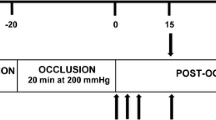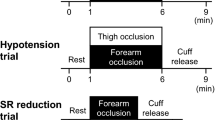Abstract
In light of the current methodological developments in flow-mediated dilation (FMD) testing and the recognition that oxidative stress may play an important role in regulating this process, the present study sought to: (1) compare flow-mediated dilation (FMD) following 5 and 10 min of forearm cuff occlusion, and (2) evaluate the role of oxidative stress on vasodilation, both distal and proximal to the cuff. Of the 14 subjects studied, 6 partook solely in a validation study of the antioxidant cocktail (AOC; vitamins C, E, and α-lipoic acid), while the remaining 8 subjects underwent FMD assessment in response to 5 and 10 min of forearm occlusion following ingestion of AOC or placebo. Although the efficacy of the AOC was clearly documented by elevated plasma ascorbate levels (~95%) and a reduced free radical concentration (~65%), no effects of acute oral antioxidants were observed. FMD was significantly augmented in response to 10 min of forearm occlusion when compared to 5 min, whether expressed as % change (10.1 ± 2 vs. 4.5 ± 1%, respectively) or absolute change in diameter (0.035 ± 0.005 vs. 0.018 ± 0.005 cm, respectively). Additionally, post-occlusion shear rate (28,640 ± 2,799 vs. 18,629 ± 1,724/s, AUC), FMD/shear rate (~50%), and time to peak dilation (68 ± 7 vs. 53 ± 8 s) were greater following 10 min of occlusion. In contrast to previous studies, this investigation has identified a greater brachial artery FMD in response to 10 versus 5 min of forearm ischemia, which appears to be unexplained by oxidative stress.





Similar content being viewed by others
References
Acree LS, Comp PC, Whitsett TL, Montgomery PS, Nickel KJ, Fjeldstad AS, Fjeldstad C, Gardner AW (2007) The influence of obesity on calf blood flow and vascular reactivity in older adults. Dyn Med 6:4
Agewall S, Hulthe J, Fagerberg B, Gottfridsson B, Wikstrand J (2002) Post-occlusion brachial artery vasodilatation after ischaemic handgrip exercise is nitric oxide mediated. Clin Physiol Funct Imaging 22:18–23
Bailey DM, Davies B, Young IS, Jackson MJ, Davison GW, Isaacson R, Richardson RS (2003) EPR spectroscopic detection of free radical outflow from an isolated muscle bed in exercising humans. J Appl Physiol 94:1714–1718
Bailey DM, Ainslie PN, Jackson SK, Richardson RS, Ghatei M (2004) Evidence against redox regulation of energy homoeostasis in humans at high altitude. Clin Sci (Lond) 107:589–600
Bellien J, Iacob M, Gutierrez L, Isabelle M, Lahary A, Thuillez C, Joannides R (2006) Crucial role of NO and endothelium-derived hyperpolarizing factor in human sustained conduit artery flow-mediated dilatation. Hypertension 48:1088–1094
Betik AC, Luckham VB, Hughson RL (2004) Flow-mediated dilation in human brachial artery after different circulatory occlusion conditions. Am J Physiol 286:H442–H448
Black MA, Cable NT, Thijssen DH, Green DJ (2008) Importance of measuring the time course of flow-mediated dilatation in humans. Hypertension 51:203–210
Corretti MC, Plotnick GD, Vogel RA (1995) Technical aspects of evaluating brachial artery vasodilatation using high-frequency ultrasound. Am J Physiol 268:H1397–H1404
Corretti MC, Anderson TJ, Benjamin EJ, Celermajer D, Charbonneau F, Creager MA, Deanfield J, Drexler H, Gehard-Herman M, Herrington D, Vallance P, Vita J, Vogel R (2002) Guidelines for the ultrasound assessment of endothelial-dependent flow-mediated vasodilation of the brachial artery. J Am Coll Cardiol 39:257–265
Darley-Usmar V, Wiseman H, Halliwell B (1995) Nitric oxide and oxygen radicals: a question of balance. FEBS Lett 369:131–135
Davies PF, Tripathi SC (1993) Mechanical stress mechanisms and the cell. An endothelial paradigm. Circ Res 72:239–245
Eskurza I, Monahan KD, Robinson JA, Seals DR (2004) Effect of acute and chronic ascorbic acid on flow-mediated dilatation with sedentary and physically active human ageing. J Physiol 556:315–324
Giraldez RR, Panda A, Xia Y, Sanders SP, Zweier JL (1997) Decreased nitric-oxide synthase activity causes impaired endothelium-dependent relaxation in the postischemic heart. J Biol Chem 272:21420–21426
Green D (2005) Point: flow-mediated dilation does reflect nitric oxide-mediated endothelial function. J Appl Physiol 99:1233–1234 (discussion 1237–1238)
Harris RA, Follett DH, Halliwell M, Wells PN (1991) Ultimate limits in ultrasonic imaging resolution. Ultrasound Med Biol 17:547–558
Harris RA, Padilla J, Rink LD, Wallace JP (2006) Variability of flow-mediated dilation measurements with repetitive reactive hyperemia. Vasc Med 11:1–6
Imms FJ, Lee WS, Ludlow PG (1988) Reactive hyperaemia in the human forearm. Q J Exp Physiol 73:203–215
Joannides R, Haefeli WE, Linder L, Richard V, Bakkali EH, Thuillez C, Luscher TF (1995) Nitric oxide is responsible for flow-dependent dilatation of human peripheral conduit arteries in vivo. Circulation 91:1314–1319
Johns RA, Linden JM, Peach MJ (1989) Endothelium-dependent relaxation and cyclic GMP accumulation in rabbit pulmonary artery are selectively impaired by moderate hypoxia. Circ Res 65:1508–1515
Kooijman M, Thijssen DHJ, de Groot PCE, Bleeker MWP, van Kuppevelt HJM, Green DJ, Rongen GA, Smits P, Hopman MTE (2008) Flow-mediated dilatation in the superficial femoral artery is nitric oxide mediated in humans. J Physiol 586:1137–1145
Leeson P, Thorne S, Donald A, Mullen M, Clarkson P, Deanfield J (1997) Non-invasive measurement of endothelial function: effect on brachial artery dilatation of graded endothelial dependent and independent stimuli. Heart 78:22–27
Mitchell GF, Parise H, Vita JA, Larson MG, Warner E, Keaney JF Jr, Keyes MJ, Levy D, Vasan RS, Benjamin EJ (2004) Local shear stress and brachial artery flow-mediated dilation: the Framingham Heart Study. Hypertension 44:134–139
Mullen MJ, Kharbanda RK, Cross J, Donald AE, Taylor M, Vallance P, Deanfield JE, MacAllister RJ (2001) Heterogenous nature of flow-mediated dilatation in human conduit arteries in vivo: relevance to endothelial dysfunction in hypercholesterolemia. Circ Res 88:145–151
Neunteufl T, Kostner K, Katzenschlager R, Zehetgruber M, Maurer G, Weidinger F (1998) Additional benefit of vitamin E supplementation to simvastatin therapy on vasoreactivity of the brachial artery of hypercholesterolemic men. J Am Coll Cardiol 32:711–716
Nishiyama SK, Wray DW, Berkstresser K, Ramaswamy M, Richardson RS (2007) Limb-specific differences in flow-mediated dilation: the role of shear rate. J Appl Physiol 103:843–851
Plantinga Y, Ghiadoni L, Magagna A, Giannarelli C, Franzoni F, Taddei S, Salvetti A (2007) Supplementation with vitamins C and E improves arterial stiffness and endothelial function in essential hypertensive patients. Am J Hypertens 20:392–397
Pleiner J, Schaller G, Mittermayer F, Marsik C, MacAllister RJ, Kapiotis S, Ziegler S, Ferlitsch A, Wolzt M (2008) Intra-arterial vitamin C prevents endothelial dysfunction caused by ischemia-reperfusion. Atherosclerosis 197:383–391
Pyke KE, Tschakovsky ME (2007) Peak vs. total reactive hyperemia: which determines the magnitude of flow-mediated dilation? J Appl Physiol 102:1510–1519
Pyke KE, Dwyer EM, Tschakovsky ME (2004) Impact of controlling shear rate on flow-mediated dilation responses in the brachial artery of humans. J Appl Physiol 97:499–508
Richardson RS, Donato AJ, Uberoi A, Wray DW, Lawrenson L, Nishiyama S, Bailey DM (2007) Exercise-induced brachial artery vasodilation: role of free radicals. Am J Physiol 292:H1516–H1522
Sinoway LI, Hendrickson C, Davidson WR Jr, Prophet S, Zelis R (1989) Characteristics of flow-mediated brachial artery vasodilation in human subjects. Circ Res 64:32–42
Szabo C (1996) The pathophysiological role of peroxynitrite in shock, inflammation, and ischemia-reperfusion injury. Shock 6:79–88
Title LM, Cummings PM, Giddens K, Genest JJ Jr, Nassar BA (2000) Effect of folic acid and antioxidant vitamins on endothelial dysfunction in patients with coronary artery disease. J Am Coll Cardiol 36:758–765
Tschakovsky ME, Pyke KE (2005) Counterpoint: flow-mediated dilation does not reflect nitric oxide-mediated endothelial function. J Appl Physiol 99:1235–1237
Vuilleumier JP, Keck E (1993) Fluorometric assay of vitamin C in biological materials using a centrifugal analyser with fluorescence attachment. J Micronutr Anal 5:25–34
Wendelhag I, Fagerberg B, Wikstrand J (1999) Adding ischaemic hand exercise during occlusion of the brachial artery increases the flow-mediated vasodilation in ultrasound studies of endothelial function. Clin Physiol 19:279–283
Woodman RJ, Playford DA, Watts GF, Cheetham C, Reed C, Taylor RR, Puddey IB, Beilin LJ, Burke V, Mori TA, Green D (2001) Improved analysis of brachial artery ultrasound using a novel edge-detection software system. J Appl Physiol 91:929–937
Wray DW, Uberoi A, Lawrenson L, Richardson RS (2006) Evidence of preserved endothelial function and vascular plasticity with age. Am J Physiol 290:H1271–H1277
Wray DW, Uberoi A, Lawrenson L, Bailey DM, Richardson RS (2009) Oral antioxidants and cardiovascular health in the exercise-trained and untrained elderly: a radically different outcome. Clin Sci 116:433–441
Zweier JL, Talukder MAH (2006) The role of oxidants and free radicals in reperfusion injury. Cardiovasc Res 70:181–190
Acknowledgments
The authors would like to give a special thanks to all the subjects who participated in this investigation. This study was funded in part by Tobacco-Related Disease Research Program Grant 15RT-0100, NIH PO1 HL 09183-01A1, American Heart Association grant 0835209N, and the Parker B. Francis Foundation.
Author information
Authors and Affiliations
Corresponding author
Rights and permissions
About this article
Cite this article
Harris, R.A., Nishiyama, S.K., Wray, D.W. et al. The effect of oral antioxidants on brachial artery flow-mediated dilation following 5 and 10 min of ischemia. Eur J Appl Physiol 107, 445–453 (2009). https://doi.org/10.1007/s00421-009-1147-x
Accepted:
Published:
Issue Date:
DOI: https://doi.org/10.1007/s00421-009-1147-x




